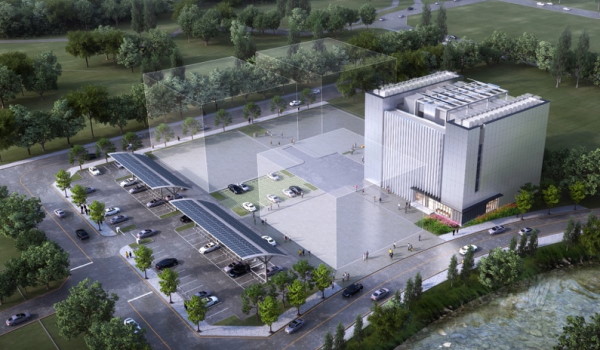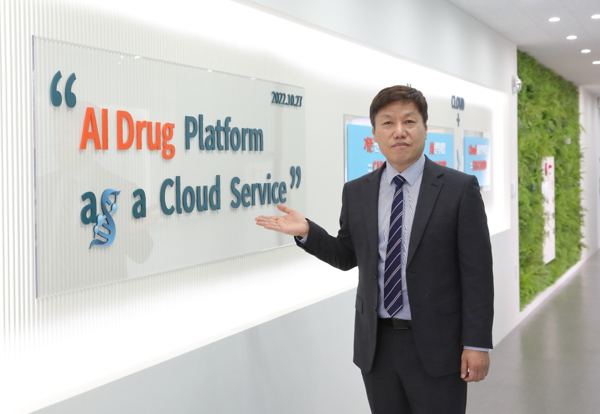Sponsored by Syntekabio
How to Discover a Preclinical Drug Candidate in Two Years
Recent advances in artificial intelligence (AI) has played a pivotal role in optimizing the small-molecule synthesis, standardization, scalability and CRO-based validation. Despite a dose of skepticism about the growing hype around AI, introducing greater automation to a drug design hypothesis has enabled more effectual searches for various compound characteristics concerning efficacy, pharmacokinetics and safety.
Many cases have gone to the application stage after completing clinical trials, though conceptual, technical and organizational challenges still remain. Standardization and scalability have been difficult in traditional drug development due to diversity and specificity of the protein targets. A widening technological gap between development companies yet exists.
STB CLOUD by Syntekabio unveiled at the BIO International Convention in Boston is one of the promising one-stop drug development cloud services for expediting drug development time frames for active compound discovery and optimization of efficacy. But can it deliver a preclinical candidate in two years?
Accelerating AI Drug Discovery: Syntekabio's Journey
The biggest cause of clinical failure of new drug candidates is insufficient optimization of candidate compounds. Hence, ‘optimization’ is a key process for increasing the probability of clinical success by accelerating and streamlining new drug development. Generally, the biopharma industry shares the goal of discovering novel drug candidates faster and more efficiently. Syntekabio is no exception in this regard.
The company’s ongoing AI-drug pipeline projects include large-scale verification and algorithm performance improvement. It leverages Alphafold2 and ESMFold to obtain multiple candidates for numerous targets concurrently, along with various structural information with high reliability. This AI new drug development method has also made it possible to develop new drugs for target proteins without ligand binding information.
New drug development depends on the process of discovering active substances, then deriving lead substances based on them. Derivation of lead substances is a task considered to be more difficult than finding active substances. It needs to meet many essential drug development conditions, such as activity and physical property improvement, toxicity mitigation, and metabolic degree control, etc.
Syntekabio is in the process of optimizing drugs for about 100 types of active substances, including 58 types of drug-target protein combinations secured through drug re-purposing. Substances selected for optimization are those with an IC50 of approximately 1.5nM to 30uM, which have various purposes for each substance-target protein.
Substances with low IC50 values and good binding power are used to screen for derivatives to strengthen pipelines through expansion of candidate compounds or to secure novelty of patents. In the case of compounds with low binding strength, derivatives are created. It is also applied for the purpose of improving the binding affinity, while securing the novelty of the existing compound. Through these various approaches, the performance of the platform for each efficacy of the active substance is confirmed. It is also used for the purpose of enhancing the performance of the lead-optimization platform.
Syntekabio’s own built-in technology eliminates errors through MD simulation. In the case of CLK2 inhibitors, for example, the company can diversify its pipeline compounds by adding four derivatives with improved inhibitory efficacy based on the parent, using the lead-optimization platform.
Through an AI-based automatic leading compound optimization platform, Syntekabio has researched on securing additional scaffolds and improving activity for about 100 candidates for active substances discovered over the past three years. This ‘Auto-Lead-Optimization’ platform includes the ‘GAP2’ algorithm that creates derivatives through substitution and addition for the purpose of forming additional substitution of R-group, using the company's more than 20,000 R-group libraries with the fixed scaffold. In the end, the optimal derivative is generated through the process of predicting and evaluating the binding mode through molecular dynamics verification (MD simulation).
AI-Enabled Discovery of a Preclinical Drug Candidate in Two Years
According to Syntekabio, the number of hits needed to backtrack and reach a preclinical drug candidate is eight. A failure to secure eight or more at the hit level would lead to several difficulties, making it impossible to finish the process in two years. If Syntekabio’s DeepMatcher® hit-discovery generates an average of two or more hits per a run time, it requires only four times to run hit-discovery to secure eight hits.
In fact, an automated environment makes it even more efficient by running four operations at once in parallel to secure all eight hits. As such, the automated environment’s scalability can guarantee shortening the development time at each stage, simply by expanding the equipment by two or four times. The drug approval rate by FDA and EMA also increases five-folds with pharmacogenomic biomarker.
Table. A 2-year completion challenge for preclinical drug candidate
| Step | TPP | Challenges | Duration (Month) |
|---|---|---|---|
|
Hit Discovery |
IC50 < 1uM ~8 Hits |
The number of hits required when tracing back to reach the preclinical drug candidate at once is 8. |
~ 4 |
|
Lead Generation |
IC50< 10nM ~4 Leads |
Success rate ~= 50% 1 |
~ 8 |
|
ADMET/PK (Preclinical Drug Candidate) |
ADMET/PK Profiles ~1 Candidates |
Success rate ~= 25% 2 (98 / 399, 2001~2010) |
~ 12 |
|
PGx Biomarker (Drug Labeling) |
Drug approval rate > 5 folds |
Drug approval rate with Biomarkers 3 |
~ 6 |
|
1 Victoria et al. The challenges of hit-to-lead in drug discovery. Drug Target Review. 2019, 7 2 Tohru et al. The Current Status of Drug Discovery and Development. Clin Transl Sci. 2018, 11 3 Parker et al. Does biomarker use in oncology improve clinical trial failure risk? A large-scale analysis. Cancer Medicine. 2021, 10 |
|||
Syntekabio’s Disease Indications and Drug Targets
Extracting information on the 3D binding structure of a target protein and compound makes a basis for any AI drug project. Protein structure is identified via X-ray crystallography or cryogenic microscopy, but it is an expensive and time-consuming experiment. Only about 30% of human genes is known to be identified using this method. However, ‘AlphaFold2’ from DeepMind and ‘ESMFold’ developed by Meta have made it easier to secure a 3D structure by alleviating restrictions on protein structure. AI new drug platforms such as Syntekabio’s DeepMatcher® is developed to support these experiments by processing the binding structure between proteins and compounds.
Having completed the creation of 3,518 models for 1,491 genes recently, Syntekabio is ready to proceed with new drug development. Based on the principle of modeling a target with protein-compound binding information, the company has completed preliminary work to implement a model that is highly suitable for new drug development using its own technology called ‘Smart Template.'
Target genes for ‘Smart Template’ include genes confirmed to be associated with diseases in the Human Protein Atlas, a DB that encompasses existing human proteome information, kinase, GPCR, receptor protein, and channel protein. When this model group is viewed as a target disease, it is related to 516 diseases—about 70% of 747 diseases for which gene relevance has been confirmed. The company projects developing treatments for 89 out of 110 cancer diseases to be possible, including all targets suitable for AI drug development on a large scale.
The Future of Syntekabio’s AI-inspired Drug Discovery Pipeline
Unlike traditional methods with a limited search range, active substances can be searched for hundreds of millions to billions of large-scale compounds using AI. The mechanism of action in compounds and proteins is based on physico-chemical theory, rather than trial and error through expert intuition.
For instance, Syntekabio has been conducting a large-scale ‘drug re-purposing’ project since the second half of 2021. It recently completed verification of the results through biochemical assays. 3,355 substances—including FDA-approved drugs—were applied to 523 three-dimensional protein models owned by the company at the time. Verification of these substances was carried out in an ‘all against all’ method, with 437 combinations identified and passing the internal standards as a result of the verification. Of these, 58 combinations showed more than 50% inhibition activity at a concentration of 1uM or less. Animal experiments for these are currently in progress for a number of drugs, with their effectiveness confirmed. Such a large-scale excavation and verification work is of great significance in terms of platform advancement and securing candidate substance.
Even in projects where the development difficulty was once high, it may be possible now to sufficiently derive active substances and lead substances with the development of advanced AI algorithms. In this environment, Syntekabio is considering revamping some of the failed drug projects from other institutions, since the company's supercomputing infrastructure can easily support dozens of AI new drug projects simultaneously. Above all, Syntekabio’s ability to simulate as many targets as needed with the AI drug platform will greatly increases the success rate of new drug development. Advances in algorithms will also continue to improve AI, which in turn will enhance the life cycle of drug development to be more precise and efficient.
Furthermore, FDA and EMA recognize the potential of pharmacogenomic biomarkers to improve patient outcomes and the practice of precision medicine. AI, together with pharmacogenomic biomarkers as part of the drug approval process, has become an important tool in drug development and personalized medicine. Syntekabio’s technologies can help better understand the patients’ genetic makeup and explore how genetic variations can impact drug efficacy, dosage recommendations, and potential adverse effects in the long term.
Topics: AI & Digital

